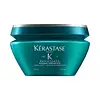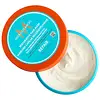What's inside
What's inside
 Key Ingredients
Key Ingredients

 Benefits
Benefits

 Concerns
Concerns

 Ingredients Side-by-side
Ingredients Side-by-side

Water
Skin ConditioningCetearyl Alcohol
EmollientParaffinum Liquidum
EmollientOrbignya Oleifera Seed Oil
EmollientDipalmitoylethyl Hydroxyethylmonium Methosulfate
Parfum
MaskingCetyl Esters
EmollientCetrimonium Chloride
AntimicrobialCaprylyl Glycol
EmollientLinalool
PerfumingCitric Acid
Buffering2-Oleamido-1,3-Octadecanediol
Skin ConditioningCitronellol
PerfumingBHT
AntioxidantGlycine
BufferingArginine
MaskingProline
Skin ConditioningTyrosine
MaskingGlutamic Acid
HumectantGeraniol
PerfumingSerine
MaskingHydroxypropyltrimonium Hydrolyzed Wheat Protein
Skin ConditioningBenzyl Alcohol
PerfumingSafflower Glucoside
Isoeugenol
PerfumingGlycerin
HumectantTrehalose
HumectantTamarindus Indica Seed Polysaccharide
Skin ConditioningMyrothamnus Flabellifolia Leaf Extract
EmollientWater, Cetearyl Alcohol, Paraffinum Liquidum, Orbignya Oleifera Seed Oil, Dipalmitoylethyl Hydroxyethylmonium Methosulfate, Parfum, Cetyl Esters, Cetrimonium Chloride, Caprylyl Glycol, Linalool, Citric Acid, 2-Oleamido-1,3-Octadecanediol, Citronellol, BHT, Glycine, Arginine, Proline, Tyrosine, Glutamic Acid, Geraniol, Serine, Hydroxypropyltrimonium Hydrolyzed Wheat Protein, Benzyl Alcohol, Safflower Glucoside, Isoeugenol, Glycerin, Trehalose, Tamarindus Indica Seed Polysaccharide, Myrothamnus Flabellifolia Leaf Extract
Water
Skin ConditioningCetearyl Alcohol
EmollientBehentrimonium Chloride
PreservativeCanola Oil
EmollientButyrospermum Parkii Butter
Skin ConditioningParfum
MaskingDimethicone
EmollientArgania Spinosa Kernel Oil
EmollientCaryocar Brasiliense Fruit Oil
Skin ConditioningHydrolyzed Vegetable Protein Pg-Propyl Silanetriol
Skin ConditioningGuar Hydroxypropyltrimonium Chloride
Skin ConditioningTocopherol
AntioxidantSorbitan Oleate
EmulsifyingPEG-60 Almond Glycerides
EmulsifyingCeteareth-20
CleansingPolyquaternium-37
PPG-1 Trideceth-6
Skin ConditioningQuaternium-98
EmollientSteareth-2
EmulsifyingCitric Acid
BufferingDimethiconol
EmollientAcrylates Copolymer
Caprylyl Glycol
EmollientIsopropyl Alcohol
SolventAcetamide Mea
HumectantDisodium EDTA
Chlorphenesin
AntimicrobialPropylene Glycol Dicaprylate/Dicaprate
EmollientStearamidopropyl Dimethylamine
EmulsifyingPolyacrylamidopropyltrimonium Chloride
Dihydrogenated Tallow Hydroxyethylmonium Methosulfate
Potassium Sorbate
PreservativeBHT
AntioxidantPhenoxyethanol
PreservativeAlpha-Isomethyl Ionone
PerfumingLinalool
PerfumingHydroxycitronellal
PerfumingWater, Cetearyl Alcohol, Behentrimonium Chloride, Canola Oil, Butyrospermum Parkii Butter, Parfum, Dimethicone, Argania Spinosa Kernel Oil, Caryocar Brasiliense Fruit Oil, Hydrolyzed Vegetable Protein Pg-Propyl Silanetriol, Guar Hydroxypropyltrimonium Chloride, Tocopherol, Sorbitan Oleate, PEG-60 Almond Glycerides, Ceteareth-20, Polyquaternium-37, PPG-1 Trideceth-6, Quaternium-98, Steareth-2, Citric Acid, Dimethiconol, Acrylates Copolymer, Caprylyl Glycol, Isopropyl Alcohol, Acetamide Mea, Disodium EDTA, Chlorphenesin, Propylene Glycol Dicaprylate/Dicaprate, Stearamidopropyl Dimethylamine, Polyacrylamidopropyltrimonium Chloride, Dihydrogenated Tallow Hydroxyethylmonium Methosulfate, Potassium Sorbate, BHT, Phenoxyethanol, Alpha-Isomethyl Ionone, Linalool, Hydroxycitronellal
Ingredients Explained
These ingredients are found in both products.
Ingredients higher up in an ingredient list are typically present in a larger amount.
BHT is a synthetic antioxidant and preservative.
As an antioxidant, it helps your body fight off free-radicals. Free-radicals are molecules that may damage your skin cells.
As a preservative, it is used to stabilize products and prevent them from degrading. Specifically, BHT prevents degradation from oxidation.
The concerns related to BHT come from oral studies; this ingredient is currently allowed for use by both the FDA and EU.
However, it was recently restricted for use in the UK as of April 2024.
Learn more about BHTCaprylyl Glycol is a humectant and emollient, meaning it attracts and preserves moisture.
It is a common ingredient in many products, especially those designed to hydrate skin. The primary benefits are retaining moisture, skin softening, and promoting a healthy skin barrier.
Though Caprylyl Glycol is an alcohol derived from fatty acids, it is not the kind that can dry out skin.
This ingredient is also used as a preservative to extend the life of products. It has slight antimicrobial properties.
Learn more about Caprylyl GlycolCetearyl alcohol is a mixture of two fatty alcohols: cetyl alcohol and stearyl alcohol. It is mainly used as an emulsifier. Emulsifiers help prevent the separation of oils and products. Due to its composition, it can also be used to thicken a product or help create foam.
Cetearyl alcohol is an emollient. Emollients help soothe and hydrate the skin by trapping moisture.
Studies show Cetearyl alcohol is non-toxic and non-irritating. The FDA allows products labeled "alcohol-free" to have fatty alcohols.
This ingredient is usually derived from plant oils such as palm, vegetable, or coconut oils. There is debate on whether this ingredient will cause acne.
Due to the fatty acid base, this ingredient may not be Malassezia folliculitis safe.
Learn more about Cetearyl AlcoholCitric Acid is an alpha hydroxy acid (AHA) naturally found in citrus fruits like oranges, lemons, and limes.
Like other AHAs, citric acid can exfoliate skin by breaking down the bonds that hold dead skin cells together. This helps reveal smoother and brighter skin underneath.
However, this exfoliating effect only happens at high concentrations (20%) which can be hard to find in cosmetic products.
Due to this, citric acid is usually included in small amounts as a pH adjuster. This helps keep products slightly more acidic and compatible with skin's natural pH.
In skincare formulas, citric acid can:
While it can provide some skin benefits, research shows lactic acid and glycolic acid are generally more effective and less irritating exfoliants.
Most citric acid used in skincare today is made by fermenting sugars (usually from molasses). This synthetic version is identical to the natural citrus form but easier to stabilize and use in formulations.
Read more about some other popular AHA's here:
Learn more about Citric AcidLinalool is a fragrance and helps add scent to products. It's derived from common plants such as cinnamon, mint, citrus, and lavender.
Like Limonene, this ingredient oxidizes when exposed to air. Oxidized linalool can cause allergies and skin sensitivity.
This ingredient has a scent that is floral, spicy tropical, and citrus-like.
Learn more about LinaloolParfum is a catch-all term for an ingredient or more that is used to give a scent to products.
Also called "fragrance", this ingredient can be a blend of hundreds of chemicals or plant oils. This means every product with "fragrance" or "parfum" in the ingredients list is a different mixture.
For instance, Habanolide is a proprietary trade name for a specific aroma chemical. When used as a fragrance ingredient in cosmetics, most aroma chemicals fall under the broad labeling category of “FRAGRANCE” or “PARFUM” according to EU and US regulations.
The term 'parfum' or 'fragrance' is not regulated in many countries. In many cases, it is up to the brand to define this term.
For instance, many brands choose to label themselves as "fragrance-free" because they are not using synthetic fragrances. However, their products may still contain ingredients such as essential oils that are considered a fragrance by INCI standards.
One example is Calendula flower extract. Calendula is an essential oil that still imparts a scent or 'fragrance'.
Depending on the blend, the ingredients in the mixture can cause allergies and sensitivities on the skin. Some ingredients that are known EU allergens include linalool and citronellol.
Parfum can also be used to mask or cover an unpleasant scent.
The bottom line is: not all fragrances/parfum/ingredients are created equally. If you are worried about fragrances, we recommend taking a closer look at an ingredient. And of course, we always recommend speaking with a professional.
Learn more about ParfumWater. It's the most common cosmetic ingredient of all. You'll usually see it at the top of ingredient lists, meaning that it makes up the largest part of the product.
So why is it so popular? Water most often acts as a solvent - this means that it helps dissolve other ingredients into the formulation.
You'll also recognize water as that liquid we all need to stay alive. If you see this, drink a glass of water. Stay hydrated!
Learn more about Water